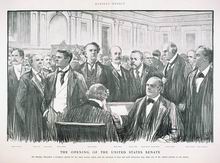Choosing Seats
Plans like these, with movable paper names of senators, are used to assign desk locations during the beginning of each new Congress.
The original 48 desks made by Thomas Constantine in 1819 were constructed in such a way as to form three concentric semicircles on the Senate floor. Each desk was custom made for a particular location within the Chamber. Today the desks are no longer arranged in their original order, instead they move from place to place to suit the needs of the Senate.
At the start of each Congress, the desks are reapportioned between the two sides of the Chamber based on the number of Democrats and Republicans. After that, senators have the opportunity to relocate. Historically the Senate Chamber desks were assigned on a first-come, first-served basis. When a seat became available, the first senator to speak for it won the right to it. Today, at the beginning of each Congress, senators are given the option to change their seats, based on seniority. There are typically two reasons a senator might want to change desks: to gain a better location within the Chamber, or to occupy a desk previously used by a particular senator.
The only desks that are not assigned in the traditional manner are the Daniel Webster Desk, which is always occupied by the senior senator from New Hampshire; the Jefferson Davis Desk, which is used by the senior senator from Mississippi; and the Henry Clay Desk, which is given to the senior senator from Kentucky. The assignment of these desks is governed by a series of Senate resolutions.

